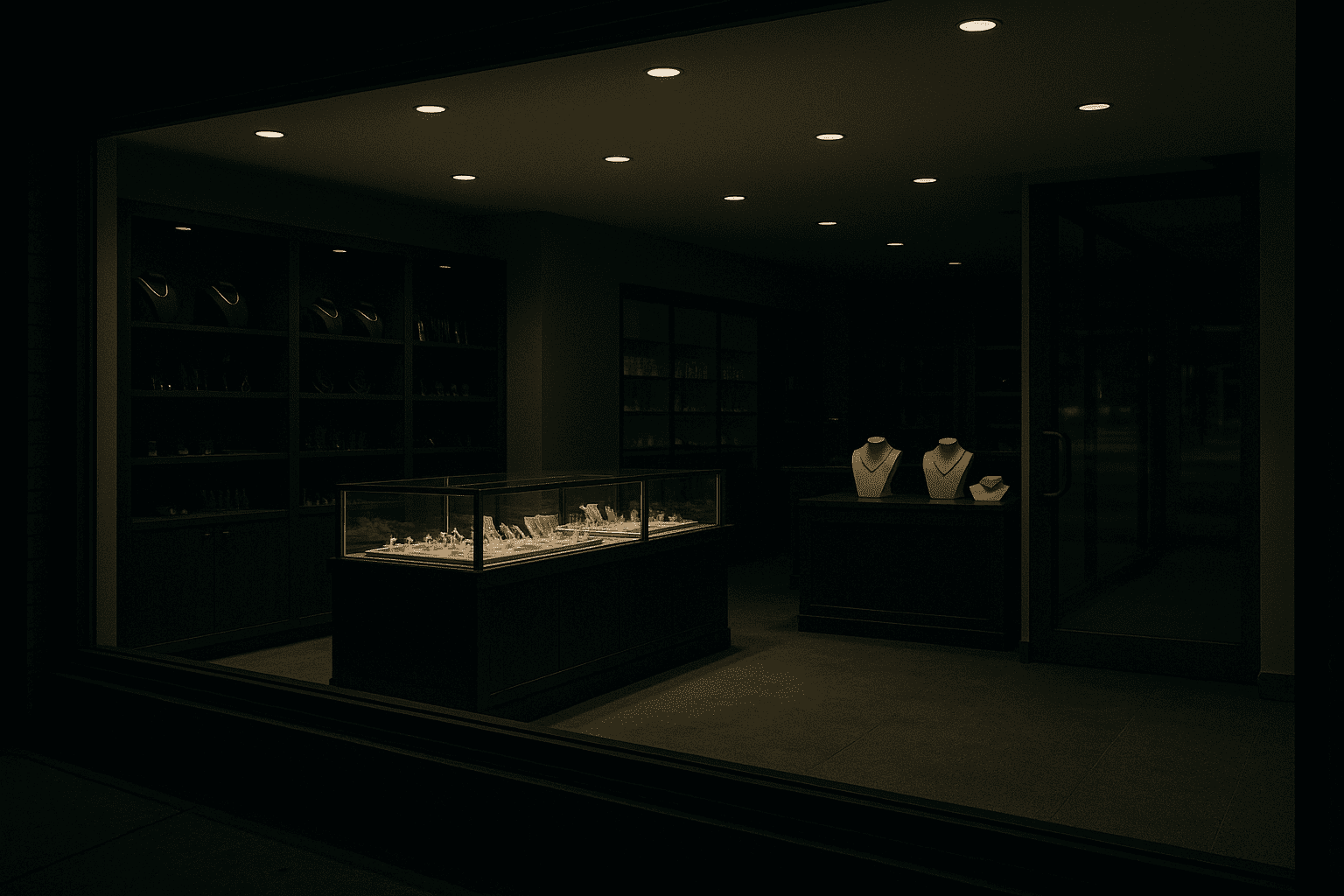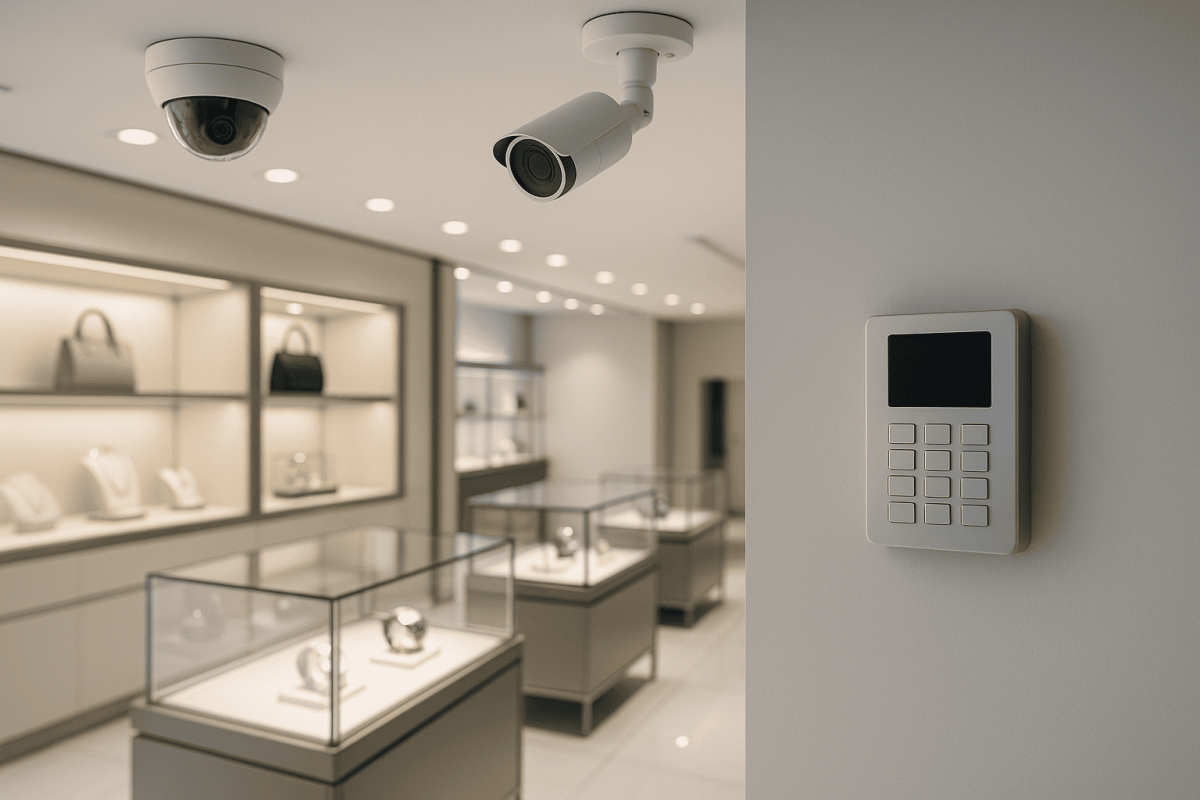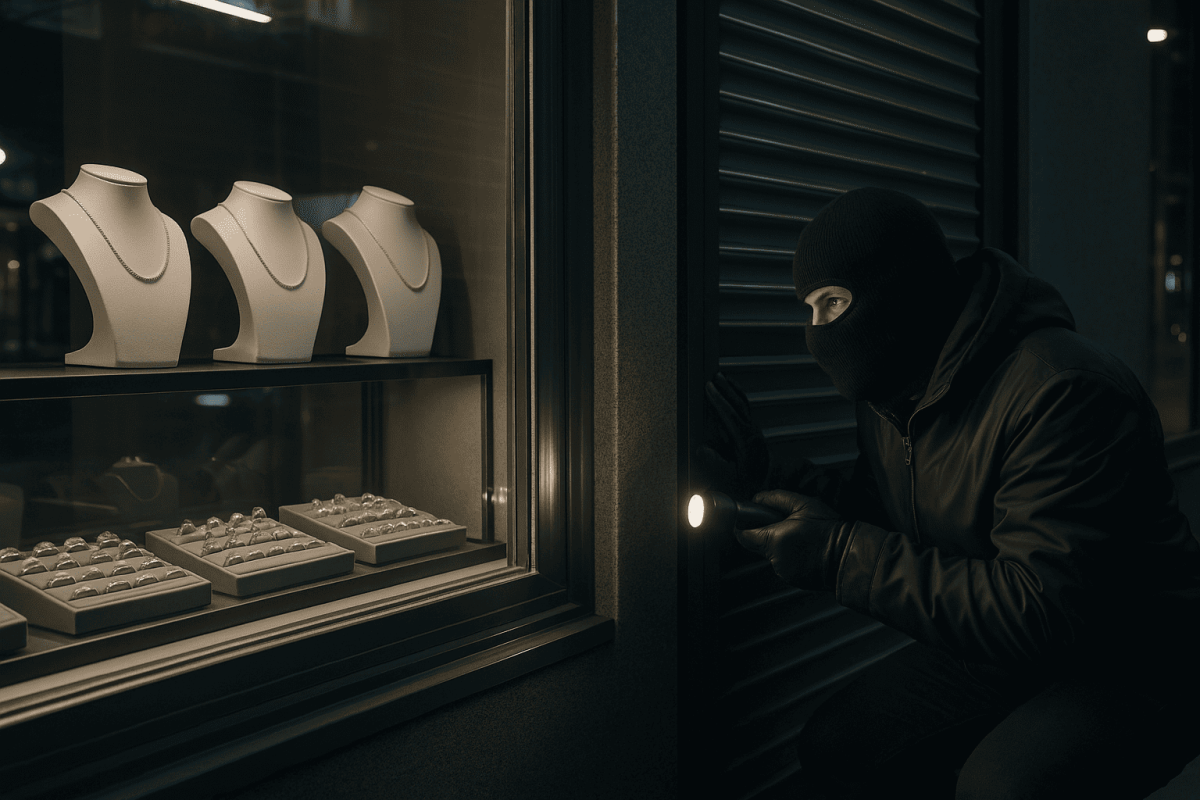Jewellery stores are among the most common retail targets for burglary and theft. Unlike supermarkets or electronics outlets, jewellery shops typically contain a large amount of high-value stock in a relatively small, accessible space. This combination makes them attractive to criminals who aim for quick and lucrative returns.
However, burglars do not target stores at random. They often observe, assess, and plan their moves based on specific weaknesses they detect in a store’s security setup, staff behaviour, or store layout.
This article serves as a practical guide to understanding what burglars look for in a store, with a focus on jewellery businesses. By identifying these vulnerabilities in advance, store owners can proactively address them before they are exploited.
What do Burglars Look for in a store?
Burglars primarily target stores for valuable, easily portable items such as cash, electronics, jewellery, and prescription medications. They also seek stores with minimal resistance: weak access points, poor lighting, visible valuables, and no real surveillance.
- Cash: Always a top priority due to its untraceable nature and immediate value.
- Valuable Goods: Electronics (laptops, tablets, smartphones), gold jewellery, diamond jewellery, gemstones, luxury handbags, luxury watches, designer clothing and accessories.
- Specific Areas: Registers, safes, inventory rooms, and anything near doors or windows.
- Ease of Access: Stores with weak locks, poor lighting, or absent surveillance systems are prime targets.
- Visible Valuables: Products displayed near entrances or storefront windows are especially tempting.
1. Poor Visibility and Lack of Surveillance
Poor visibility refers to the inability of outsiders, such as pedestrians, neighbours, or even law enforcement, to see what is happening inside or around a store. When a store is concealed by poor lighting, blocked windows, or a secluded location, it creates a favourable environment for burglars to act undetected.
Lack of surveillance adds to this vulnerability. Surveillance systems, including closed-circuit television (CCTV), alarm sensors, and real-time monitoring tools, are meant to deter criminal activity and assist in post-incident investigations. If these systems are missing or not functioning correctly, burglars are less likely to be discouraged from attempting a break-in.
Dim Lighting or Blocked Windows
Stores with dim or non-functional exterior lighting make it harder for others to observe activity around the premises, especially at night. Similarly, window displays that are obstructed by signage, curtains, or clutter reduce visibility into the store from the street. These conditions help burglars operate without fear of being seen.
No Functioning Security Cameras
Security cameras that are outdated, broken, or placed in ineffective locations provide no real deterrent to criminals. In some cases, burglars can tell when cameras are non-operational or decoys, and may feel more confident about avoiding detection.
No Real-Time Monitoring
A store that lacks 24/7 surveillance monitoring—whether by a Central Monitoring Station (CMS) or in-house staff—can be compromised for hours without anyone noticing. Delays in response time may increase the financial and operational damage caused by the intrusion.
2. Weak Entry Points and Barriers
Entry points refer to doors, windows, and any other access areas where individuals can enter or exit a building. Inadequately secured entry points are among the first things burglars assess when scouting a location. Physical barriers, such as reinforced doors, grilles, and shutters, are essential for delaying or deterring break-ins, especially after business hours.
If a store lacks strong physical defences, it becomes a much easier target for forced entry, particularly at night or during holidays when stores are unoccupied.
Old Locks or Basic Door Hardware
Doors that rely on traditional key locks or outdated latching systems can often be bypassed using basic tools such as screwdrivers, crowbars, or lock picks. These vulnerabilities are well-known to experienced burglars and require minimal effort to exploit.
Unreinforced Glass Doors and Windows
Standard glass, commonly used in retail displays or entrances, is highly vulnerable to impact. Without reinforcement such as security film, laminated glass, or protective bars, these surfaces can be shattered quickly in smash-and-grab incidents, allowing criminals to access goods before any alarm is triggered.
No Shutters or External Barriers
Shutters and security grilles serve as an extra layer of protection after business hours. Stores without these features rely solely on glass and interior locks, which provide insufficient resistance. The absence of external barriers can make a store look neglected or under-secured, which are traits that attract criminal attention.
3. Predictable Routines and Understaffing
Routine predictability refers to store operations that follow the exact same schedule, staffing levels, and workflows each day. When a store’s activity becomes easy to anticipate, it provides burglars with the information they need to plan a low-risk break-in or theft.
Understaffing occurs when there are too few employees on the floor at certain times of day. Fewer staff members mean less oversight, slower response to suspicious activity, and greater opportunities for distraction-based crimes or inside surveillance by casing criminals.
Fixed Store Hours With No Variation
When a store opens and closes at the same times every day, burglars can use that information to plan an attack when the premises are either empty or minimally staffed. This is especially dangerous for stores that close at predictable hours without additional after-hours security.
Minimal Staff Coverage at Certain Times
Jewellery stores that operate with skeleton crews during slow hours, lunch breaks, or closing time become attractive targets. A single employee may not be able to respond effectively to a threat or may be easily distracted by a second accomplice.
No Surveillance During Restocking or Cleaning
Non-sales activities such as restocking inventory or cleaning the store often occur in the early morning or late evening when fewer staff are present. If these tasks are not covered by CCTV or active monitoring, they present windows of opportunity for theft or surveillance by would-be intruders.
4. High-Value Items in Obvious Locations
Jewellers often display their most valuable products—such as gold chains, diamond rings, and luxury watches—prominently to attract customer attention. However, placing high-value inventory in easily accessible or visible locations can unintentionally attract the wrong kind of attention: from burglars planning a fast theft.
Proper display strategy involves balancing visual appeal with security and discretion.
Luxury Items Placed Near Entrances or Windows
Items placed close to entrance doors or front-facing glass windows are especially vulnerable to smash-and-grab incidents. These displays can be accessed quickly with minimal effort and are the most visible targets from outside the store.
Unattended Showcases During Busy Hours
Busy shopping periods often result in divided staff attention. If display cases are left unattended while salespeople focus on other customers, shoplifters or coordinated teams can exploit the moment to remove items unnoticed.
No Rotation or Reconfiguration of Displays
Burglars sometimes visit a store multiple times before executing a theft. If display layouts remain the same for long periods, it becomes easier for criminals to memorise the placement of specific items and plan an efficient heist.
5. No Alarms or Functional Security Systems
Security technology plays a critical role in preventing, detecting, and responding to burglary attempts. Stores without alarms, or those using outdated or malfunctioning systems, present easier targets for experienced criminals. In many cases, the absence of a deterrent is enough to encourage an attempted break-in.
No Alarm System or Delayed Alerts
Alarm systems are essential for triggering fast responses from store managers, security firms, or law enforcement. Stores that lack alarms—or have systems with delayed notifications—allow burglars more time to complete their theft before intervention occurs.
Missing Motion Detectors or Glass-Break Sensors
While general alarms provide broad protection, specialised sensors help secure overlooked areas. Motion detectors and glass-break sensors are particularly effective in identifying intrusions that do not trip standard door contacts. Omitting these elements creates blind spots in the store’s security coverage.
Frequent False Alarms
False alarms caused by poor calibration, faulty devices, or environmental triggers can lead to complacency. Over time, staff may stop taking alarms seriously, increasing the likelihood that a real threat will be ignored or responded to too slowly.
6. Staff Untrained in Security Procedures
Staff play a critical role in day-to-day loss prevention. However, without proper training, they may fail to recognise or appropriately respond to early warning signs of criminal activity. Security training equips employees with the awareness and tools needed to protect the store and themselves.
No Awareness of Suspicious Behaviours
Shoplifters and burglars often exhibit patterns of behaviour such as repeated visits, avoidance of eye contact, or overly specific questions about security systems. Employees unfamiliar with these cues are less likely to detect and report potentially dangerous individuals.
No Emergency Action Plan (EAP) Training
When emergencies occur, such as a robbery in progress or an attempted break-in, staff must act quickly and according to a pre-established plan. Without Emergency Action Plan (EAP) training, employees may panic, delay response times, or put themselves at risk.
Unrestricted Access to Sensitive Areas
Valuable stock, safes, or storage areas should be off-limits to unauthorised staff. Stores that lack role-based access control may increase their exposure to internal theft or allow outsiders to exploit unmonitored zones.
7. Inconsistent Inventory Management
Effective inventory control is vital for identifying theft, reducing loss, and maintaining insurance eligibility. Poor inventory management makes it easier for both external and internal theft to go unnoticed, sometimes for weeks or even months.
No Regular Inventory Audits
Auditing helps reconcile actual inventory with sales records and highlights discrepancies. Without consistent checks, missing items may only be discovered after it’s too late for recovery or insurance claims.
Poor Asset Documentation
Jewellery stores should maintain detailed records, including serial numbers, valuations, and photographs of each high-value item. This documentation is crucial for filing police reports and insurance claims. Missing or vague records complicate investigations and may result in denied compensation.
No Access Tracking for Storerooms or Vaults
Tracking who enters secure areas—using electronic logs, keypads, or biometric access—is essential for accountability. Without access controls, it becomes difficult to identify the source of losses or confirm the chain of custody for missing items.
8. Lack of Jeweller’s Block Insurance
Even with the best physical safeguards, no security system is completely foolproof. When a loss does occur, insurance is often the only line of financial defence. However, most generic business insurance policies do not provide adequate coverage for the specific risks faced by jewellers.
Generic Business Insurance Often Has Exclusions
Standard commercial insurance policies often exclude coverage for high-value goods, theft of consignment stock, or damage from transit. Even if jewellery is included, there may be strict caps on payout amounts or extensive documentation requirements that are difficult to meet after a crisis.
No Protection for Transit, Consignment, or Stock-in-Trade
Jewellery that is being transported, exhibited, or held on consignment is often not covered by basic insurance policies. These activities require specialised underwriting that considers the elevated risks involved.
Stop Being an Easy Target
Burglars do not randomly select their victims—they actively seek out stores with poor visibility, weak defences, and inconsistent operational routines. Many of these vulnerabilities are avoidable through proper staff training, up-to-date surveillance, secure displays, and strong access control protocols.
AEG – Anglo East Group (Malaysia) offers jewellers’ block insurance in Malaysia with instant policy issuance, unlimited coverage, and 40+ years of experience—trusted by jewellers across Southeast Asia. Secure your store before vulnerabilities become losses.




